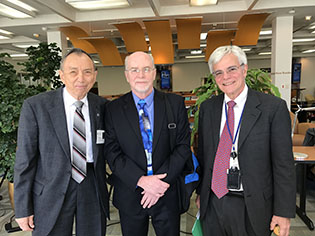Innovations: John O’Shea and Arthritis Drug
Government Collaboration with Industry Helps Drug Development
You may have seen ads on television for Xeljanz (tofacitinib), a drug used to treat rheumatoid arthritis. Don’t ask me where the name came from. But I can tell you that the drug itself was the brainchild of NIH physician and immunologist John O’Shea. O’Shea, who is the scientific director of the National Institute of Arthritis and Musculoskeletal and Skin Diseases (NIAMS), described his work at the Philip S. Chen, Jr. Distinguished Lecture on Innovation and Technology Transfer on October 14.
Chen and members of his family were in the audience and thoroughly enjoyed O’Shea’s talk. Chen spent four decades at NIH, established the NIH Office of Technology Transfer, and created the Cooperative Research and Development Agreement (CRADA).
The CRADA has become an essential component of technology transfer and allows NIH researchers to collaborate with industry scientists. Essentially, it gives private companies access to the wealth of information produced in government research laboratories while also preserving the intellectual property rights of that company. The government, for its part, has access to the financial backing and mass-production capabilities of industry.

At the Chen Lecture, NIAMS scientist John O'Shea described how he collaborated with industry to develop tofacitinib, a drug used to treat rheumatoid arthritis.
“The CRADA [is] an exceptionally effective mechanism for government collaboration with industry,” said O’Shea.
He described how the development of tofacitinib began as an informal discussion with Paul Changelian of Pfizer in 1993. O’Shea found that getting an industry perspective on his drug research was invaluable. Pharmaceutical companies have different needs and goals that are seldom addressed in academia or government. Equally important were Changelian’s efforts to champion the project. Changelian had the scientific insight from his previous academic work in immunology as well as the right contacts at Pfizer to set things in motion.
At the time, Changelian and Pfizer were searching for kinases. These are proteins that transfer phosphate groups to other proteins, typically to activate them. As luck would have it, O’Shea’s research team had recently discovered a new kinase called Janus kinase 3 (JAK3), which had drug-target potential. The JAK family encompasses a group of kinases (JAK1, JAK2, JAK3, and TYK2) that are important in multiple cell-signaling pathways. To communicate with each other during an immune response, cells secrete proteins called cytokines, which bind to receptors on the surfaces of other cells. The external binding activates internal JAKs, which help convey messages to the nucleus and activate target genes. Because cytokines are key to the immune response, O’Shea and Changelian hypothesized that JAK inhibitors could potentially treat autoimmune disorders or prevent organ rejection in transplant patients.
That informal discussion between the two scientists (at a 1993 immunology meeting in Vermont) initiated a nearly two-decades-long process that included identifying potential inhibitors, testing them in animals and humans, and finally FDA approval of tofacitinib in 2012. The drug is prescribed for the treatment of moderate to severe rheumatoid arthritis, but additional work suggests that it could be effective in treating other forms of arthritis, inflammatory bowel disease, psoriasis, autoimmune alopecia, and lupus.

PHOTO BY: RICHARD WYATT, OIR
Phil Chen (left) and his family as well as Deputy Director for Intramural Research, Michael Gottesman (right), enjoyed a talk by John O’Shea (center) at the Philip S. Chen, Jr. Distinguished Lecture on Innovation and Technology Transfer.
O’Shea pointed out that the NIH-Pfizer collaboration continues to be valuable. Through the current collaboration, Pfizer has access to the NIH Clinical Center for lupus clinical trials that can inform decisions in the pharmaceutical industry. Meanwhile, the NIH gains a valuable ally in that industry and a conduit to large-scale production.
“The perception is that it is hard for government scientists to work with industry,” said O’Shea. “But both sides being committed can make it happen.”
It’s through this kind of collaboration, made possible by the CRADA, that drugs like tofacitinib can make it to the market.
For more about John O’Shea, go to https://irp.nih.gov/pi/john-oshea.
This page was last updated on Monday, April 11, 2022
